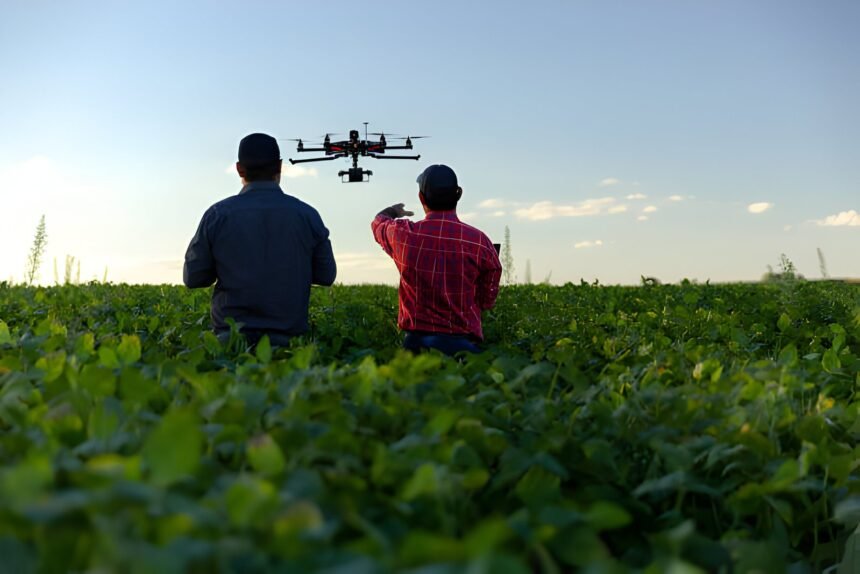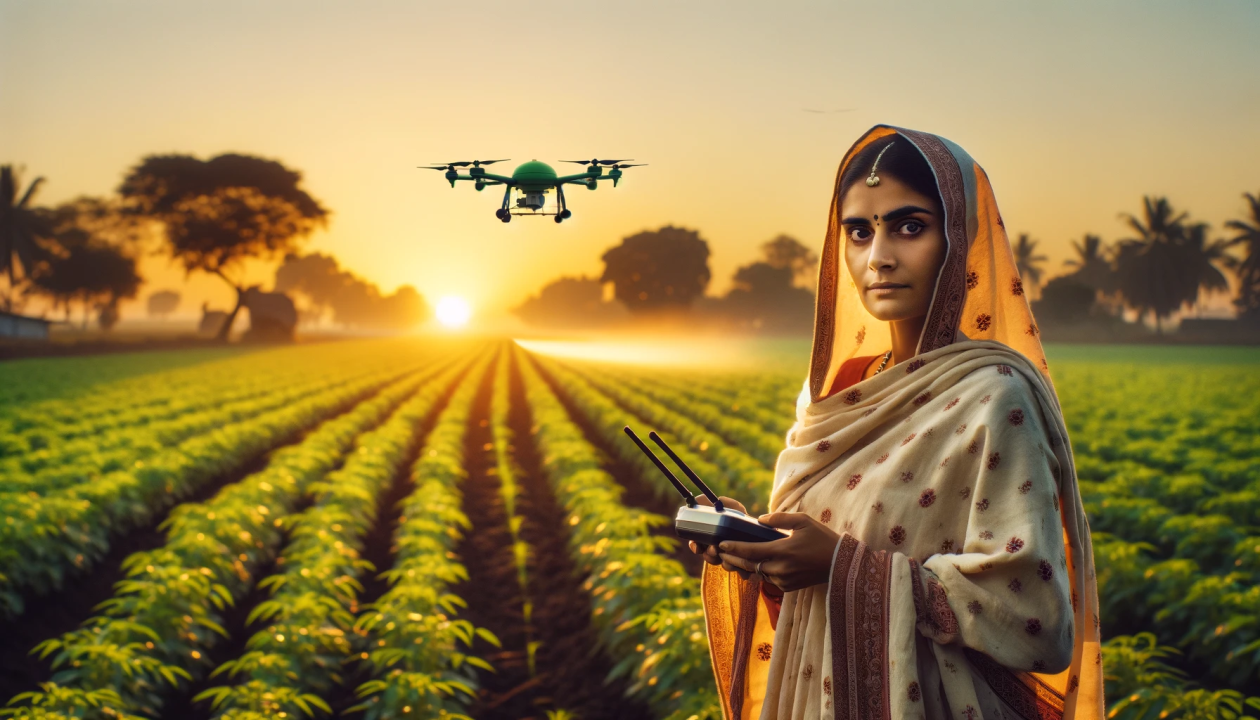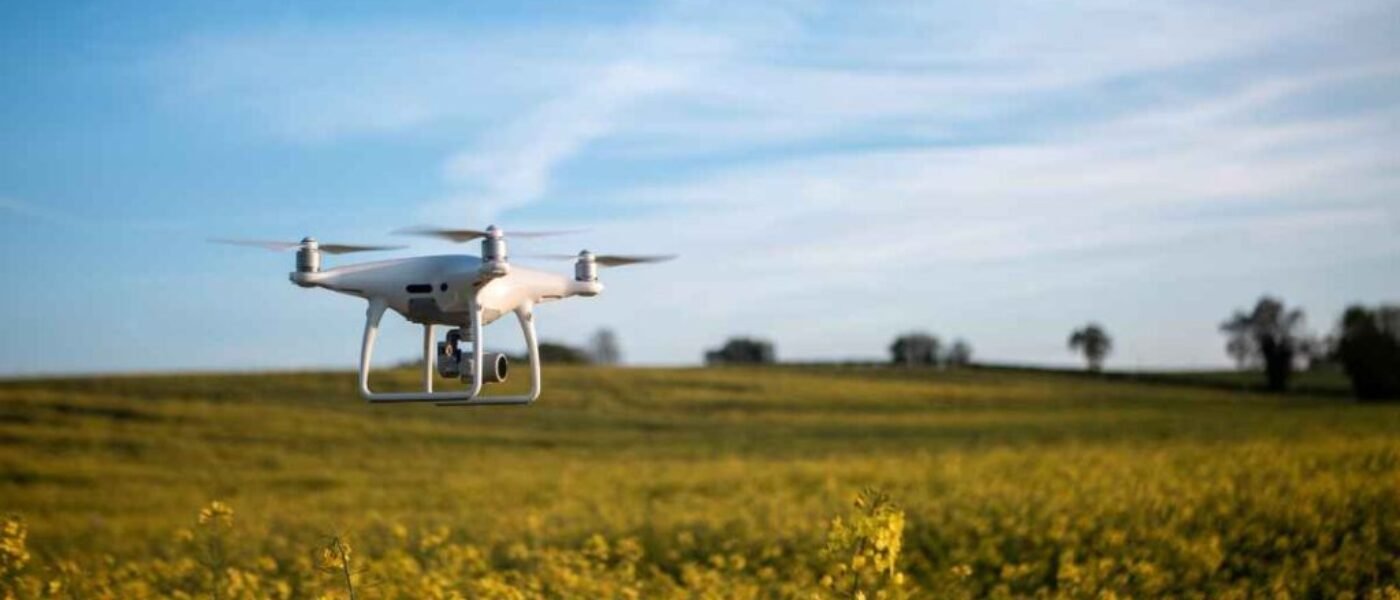Precision agriculture is rapidly transforming farming practices in India, driven by state-of-the-art drone technology. As the agricultural sector seeks solutions for sustainable and efficient farming methods, precision agriculture offers promise by reducing resource waste and increasing crop yields. This blog delves into how drones are leading this revolution, examining their impact on monitoring crop health, optimizing irrigation, and minimizing environmental footprint. Join us as we explore the pivotal role of drones in creating a more efficient farming landscape across India.
How Use of Drones in Precision Agriculture is Revolutionizing Farming in India
Introduction
In the vast and vibrant agricultural landscape of India, farming is taking a high-tech turn with the introduction of drone technology. As farmers face challenges like climate change and resource scarcity, precision agriculture with drones is proving to be a game-changer. These flying gadgets aren’t just about capturing stunning aerial photos; they’re pivotal in promoting sustainable and smart farming. By helping farmers monitor crops, manage resources efficiently, and increase productivity, drones are redefining the future of Indian agriculture.
The Rise of Precision Agriculture in India

Overview of Precision Agriculture
Precision agriculture is a farming management concept that uses technology to observe, measure, and analyze the needs of individual crops and fields. This approach allows farmers to apply resources like water, fertilizers, and pesticides more efficiently. By focusing on the specific needs of their crops, farmers can improve yield, reduce waste, and farm more sustainably. Precision agriculture incorporates a variety of technologies, such as GPS, satellite imagery, and, more recently, drones, to achieve a high level of precision in crop management.
Factors Driving Adoption in India
Several factors are contributing to the rapid adoption of precision agriculture in India. One of the most significant is the increasing population, which demands higher agricultural productivity to ensure food security. Additionally, the effects of climate change are posing new challenges, causing farmers to seek more efficient and reliable methods to sustain their crops.
Government policies have also played a role, as initiatives like the Digital India program and various agricultural subsidies encourage farmers to embrace innovative technologies. Moreover, the decline in arable land due to urbanization necessitates the need for smarter, more efficient farming practices.
Benefits of Precision Agriculture for Indian Farmers
Precision agriculture offers a host of benefits to Indian farmers. By providing detailed insights into soil health and crop conditions, it empowers farmers to make informed decisions, resulting in higher crop yields and reduced input costs. This tailored approach not only maximizes productivity but also minimizes environmental impact by reducing the overuse of water and chemicals.
Farmers also benefit from improved resource management, as precision agriculture allows them to allocate resources more effectively. Furthermore, this approach can significantly increase profitability through enhanced efficiency and sustainability, making it an attractive option for the modern Indian farmer.
The Role of Drones in Precision Agriculture
Types of Drones Used in Farming
Agricultural drones are typically categorized into two main types—fixed-wing drones and multi-rotor drones.
– Fixed-wing drones: These are similar to small planes and are often used for covering large areas. They are excellent for tasks such as surveying and mapping due to their extended flight time.
– Multi-rotor drones: These drones are more maneuverable and ideal for tasks that require precise movements like aerial photography and spraying pesticides.
Key Technologies and Features of Agricultural Drones
Agricultural drones are equipped with a variety of technologies and features that make them indispensable tools for modern farming. Key features include GPS for accurate navigation and geo-referencing, multispectral and thermal sensors to capture detailed imagery, and high-resolution cameras for precise visual data.
Advanced drones also incorporate AI and machine learning to process data and provide actionable insights directly to the farmers. This integration allows for real-time monitoring and makes it easier to identify issues such as pest infestations or disease outbreaks.
How Drones Enhance Data Collection and Analysis
Drones revolutionize data collection and analysis by providing quick and accurate field assessments. They effortlessly capture high-resolution images and videos, which can then be analyzed to assess plant health, soil moisture levels, and weather conditions.
By combining drone data with software analytics, farmers gain a comprehensive view of their fields and can detect trends and anomalies that would be invisible to the naked eye. This information helps farmers make data-driven decisions, optimizing productivity and ensuring sustainable farming practices are followed.
By leveraging drones in precision agriculture, Indian farmers can overcome traditional challenges, improve efficiency, and pave the way towards a more sustainable future.
Impact of Drones on Crop Monitoring
Real-time Crop Health Monitoring
Drones have taken off in Indian agriculture, especially when it comes to monitoring crop health. Think of drones as the eyes in the sky, providing farmers with up-to-date information about their fields. Equipped with advanced sensors and cameras, these flying gadgets can capture detailed images of crops. These images help in assessing plant health by analyzing factors like chlorophyll levels. By knowing what’s happening in real-time, farmers can make informed decisions about their crops, ensuring timely interventions and reducing the risk of crop failure.
Early Pest and Disease Detection
One of the most significant challenges for farmers is dealing with pests and diseases. Traditionally, spotting the first signs of such issues could be like searching for a needle in a haystack, often resulting in delayed treatments. However, with drones, farmers can now detect pests and diseases early on. By flying over the fields consistently, drones can identify problem areas before they become widespread, allowing for quick and targeted responses. This proactive approach not only helps save the crops but also reduces the need for excessive pesticide use, promoting more sustainable farming practices.
Impact on Crop Yield and Quality
Not only can drones monitor and detect issues, but they also play a crucial role in enhancing crop yield and quality. By using the data collected by drones, farmers can adjust their farming techniques to optimize crop growth. Improved precision in managing nutrients, water, and pest control directly influences the yield and quality of the crops. This is especially important in a country like India, where maximizing agricultural output is critical for feeding a growing population. Enhanced crop yields not only improve the livelihoods of farmers but also contribute to the overall food security in the region.
Optimizing Irrigation with Drones
Precision Irrigation Techniques
Water is a precious resource, and in agriculture, using it wisely is more important than ever. Drones help implement precision irrigation techniques by providing detailed maps of soil moisture across a field. With this information, farmers can apply water only where it is needed, in the exact quantities required. It’s like giving each plant just the right amount of water to thrive. This level of precision helps prevent overwatering and ensures that every drop counts, making irrigation both efficient and effective.
Water Usage Efficiency and Conservation
With climate change impacting water availability, increasing water efficiency in agriculture is crucial. Drones contribute significantly to water conservation by optimizing irrigation schedules and reducing waste. By accurately assessing how much water fields need, drones enable farmers to conserve water without sacrificing crop health. This not only supports sustainable farming but also aligns with global efforts to ensure water availability for future generations.
Case Studies of Successful Implementation
The success stories of drone-assisted irrigation in India are truly inspiring. One example is a farming community in Maharashtra that faced severe water shortages. By adopting drone technology, these farmers were able to reduce water usage by 30% while increasing crop production. Another case from Punjab saw substantial improvements in yield quality and irrigation efficiency after implementing drone-guided irrigation systems. These examples highlight how drone technology can revolutionize traditional farming practices, providing a pathway for others to follow.
By integrating drones into the core of crop monitoring and irrigation, Indian farmers are paving the way for smarter and more sustainable agriculture. This technological revolution not only helps save resources but also ensures a better future for farming communities across the nation.
Environmental Benefits of Drone Technology
Reducing Chemical Usage and Environmental Harm
When it comes to farming, the use of chemicals such as fertilizers and pesticides is often necessary but can have detrimental effects on the environment. Here’s where drones step in with a helping hand (or wing, in this case!). By employing drone technology, farmers can now apply these chemicals more precisely, targeting only the areas that truly need them. This precision not only saves money by reducing the quantity of chemicals used but also minimizes the risk of chemicals leaching into nearby water sources and harming aquatic life. The result? A healthier ecosystem that supports both agriculture and nature’s intricate web of life.
Minimizing Soil Erosion and Land Degradation
Soil is the foundation of agriculture, but it can easily be damaged through erosion or overuse. Drone technology plays a critical role in monitoring soil conditions and identifying erosion-prone areas. By providing detailed aerial images and data, drones empower farmers to take proactive measures to maintain soil health. This might include adopting soil conservation techniques or planting cover crops. With these insights, farmers can ensure their land remains productive and fertile for future generations, avoiding the pitfalls of land degradation which have plagued traditional farming methods for years.
Supporting Biodiversity and Sustainable Practices
Biodiversity is essential for a resilient farming ecosystem. Drones contribute to biodiversity by offering detailed surveillance that helps farmers understand the various plant and animal species on their land. This knowledge allows farmers to adopt sustainable farming practices such as crop rotation and integrated pest management, which support diverse habitats. By fostering an environment where multiple species can thrive, drone technology is aiding in the development of farming systems that work in harmony with nature, rather than against it. In turn, this sets the stage for sustainable farming that benefits both the environment and the community.
Challenges and Future Prospects

Regulatory and Technological Challenges
While drones offer incredible promise for agriculture, they’re not without hurdles. Regulatory frameworks in India can be complex, requiring farmers to navigate permissions and compliance issues. Moreover, there’s the matter of technological barriers, including the cost of drones and the skills needed to operate them effectively. Farmers need clear regulations and accessible training programs to fully embrace this cutting-edge technology. Addressing these challenges is vital to unlocking the full potential of drones in agriculture.
Potential for Growth and Innovation
Despite these challenges, the potential for growth and innovation in drone-assisted farming is vast. As technology improves and becomes more affordable, drones are expected to become a staple in farming practices. Innovations such as enhanced sensors, machine learning algorithms, and real-time data analytics will continue to improve the efficiency and effectiveness of drone operations. This potential for innovation opens the door to smarter farming where decisions are informed by accurate data, leading to better crop management and increased yields.
Future Trends in Drone-Assisted Farming
Looking ahead, the future of drone-assisted farming is bright and promising. Emerging trends include the development of autonomous drones capable of working around the clock without human intervention. Such advancements will streamline operations, reduce labor costs, and ensure optimum management of farming resources. Another trend is the integration of drones with other smart farming technologies like IoT devices and artificial intelligence, offering farmers a comprehensive digital toolkit to manage their farms more efficiently. As these trends evolve, the adoption of drone technology in Indian agriculture is set to revolutionize the industry, paving the way for an era of truly sustainable and smart farming practices.
Conclusion
In summary, the integration of drone technology into precision agriculture is nothing short of groundbreaking for Indian farmers. Drones have not only made farming more efficient but also more sustainable. With the ability to manage resources wisely and monitor crops meticulously, farmers are now able to produce better yields while minimizing environmental impact.
* Enhanced efficiency and sustainability help farmers save time and resources.
* Improved crop yields contribute to increased income and food security.
* A reduced environmental footprint aligns with global sustainability goals.
In a world where smart farming practices are becoming essential, the use of drones marks a significant step forward for Indian agriculture. The future of farming in India looks promising, and it’s exciting to see how these innovations will continue to evolve and contribute to sustainable farming practices across the country.
